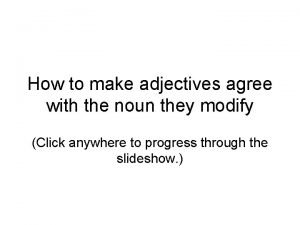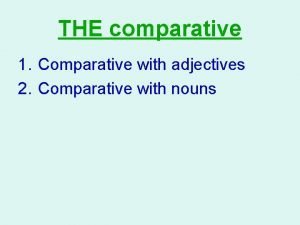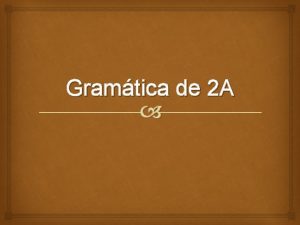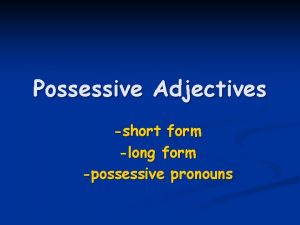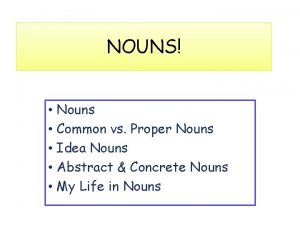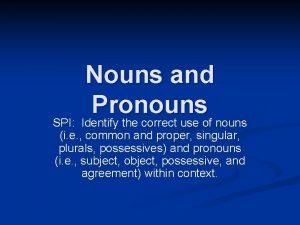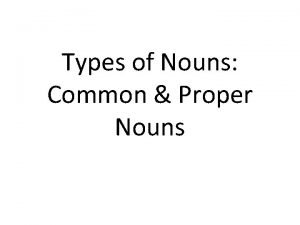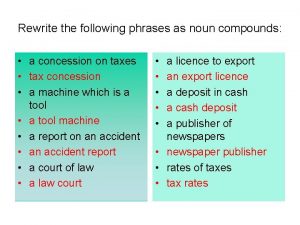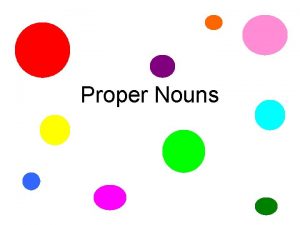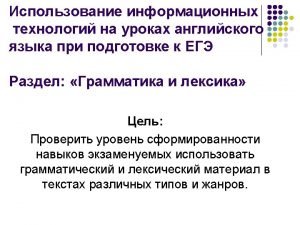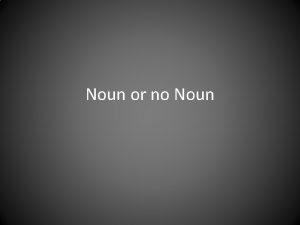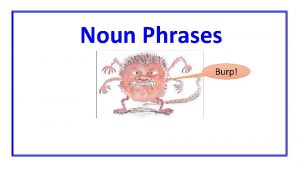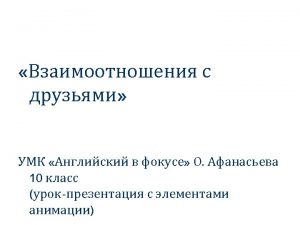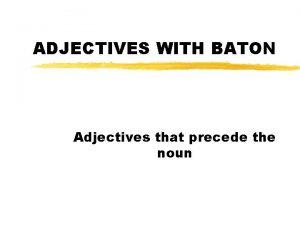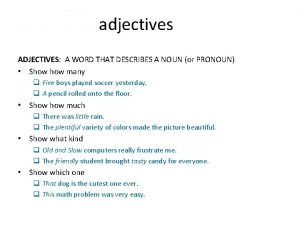How to make adjectives agree with the noun
























- Slides: 24

How to make adjectives agree with the noun they modify (Click anywhere to progress through the slideshow. )

In order to make an adjective agree with the noun it modifies, you must know whether the noun is masculine or feminine. Let’s look at some words and identify whether they are masculine or feminine…

What about the word “puerta”? Is it masculine or feminine? That’s right… it’s feminine! What about the word “libro”? Is it masculine or feminine? That’s right… it’s masculine!

What about the word “silla”? Is it masculine or feminine? That’s right… it’s feminine! What about the word “ventana”? Is it masculine or feminine? That’s right… it’s feminine!

What about the word “bolígrafo”? Is it masculine or feminine? That’s right… it’s masculine! What about the word “carro”? Is it masculine or feminine? That’s right… it’s masculine!

OK – we’ve practiced identifying masculine and feminine nouns. But we also need to know whether the noun is singular or plural. Let’s do some practice…

What about the word “puerta”? Is it singular or plural? That’s right… it’s singular! What about the word “libros”? Is it singular or plural? That’s right… it’s plural!

What about the word “sillas”? Is it singular or plural? That’s right… it’s plural! What about the word “ventana”? Is it singular or plural? That’s right… it’s singular!

What about the word “bolígrafo”? Is it singular or plural? That’s right… it’s singular! What about the word “carros”? Is it singular or plural? That’s right… it’s plural!

Now – here’s how to make the adjective agree with the noun: if you have a masculine noun like “libro” and your adjective ends in “-o”, then the adjective stays the same. For example, we’ll use the adjective “rojo” (red). un libro rojo Notice that the adjective comes AFTER the noun – in most cases adjectives will come after the noun in Spanish.

But if the noun is feminine and the adjective ends in “-o”, you must change the “-o” to an -a”. See how the adjective “rojo” changes to “roja” here: una puerta roja

Let’s compare the previous two slides. Note how the adjective that ends in “-o” stays the same with a masculine noun, but changes to “-a” with a feminine noun: un libro rojo una puerta roja

Now, some adjectives, like “verde” (green), end in “-e”. These are easy to deal with because they will stay the same whether the noun is masculine or feminine. Observe: un libro verde una puerta verde Note that the adjective “verde” stays the same regardless of whether the noun is masculine or feminine.

Let’s observe these examples using another adjective ending in “-e”: un alumno inteligente una alumna inteligente Note that the adjective “inteligente” stays the same regardless of whether the noun is masculine or feminine.

Let’s do some practice with masculine and feminine adjectives…

How would you change the adjective “anaranjado” to go with the noun “silla”? That’s right… it’s anaranjada! How would you change the adjective “interesante” to go with the noun “ventana”? That’s right… it stays the same!

How would you change the adjective “importante” to go with the noun “perro”? That’s right… it stays the same! How would you change the adjective “grande” to go with the noun “ventana”? That’s right… it stays the same!

How would you change the adjective “mojado” to go with the noun “silla”? That’s right… it’s mojada! How would you change the adjective “alto” to go with the noun “alumna”? That’s right… it’s alta!

Now we also need to look at whether the noun is singular or plural. If the noun is singular, the adjective must be singular also. If the noun is plural, the adjective must also be plural. Observe and compare the following: SINGULAR: PLURAL: un libro rojo unos libros rojos Notice in the plural example how the adjective has also been made plural.

Making adjectives plural is easy – just remember this simple rule: If the adjective ends in a vowel, you add an “-s” to make it plural. If the adjective ends in a consonant, you add an “es” to make it plural. Observe and compare the following: Adjective ending in vowel: Adjective ending in consonant: unos libros rojos unos libros azules Notice how “rojo” was changed to “rojos”, but “azul” was changed to “azules”.

Let’s do some practice with making adjectives plural…

How would you make the adjective “amarillo” (yellow) plural? That’s right… it’s amarillos! How would you make the adjective “gris” (grey) plural? That’s right… it’s grises!

How would you make the adjective “interesante” (interesting) plural? That’s right… it’s interesantes! How would you make the adjective “militar” (military) plural? That’s right… it’s militares!

VOILA! See how easy that was? Now try some on your own – click the button to do a practice quiz. Practice Quiz Replay
 Agree disagree
Agree disagree Collective noun beginning with b
Collective noun beginning with b Must agree in number with the noun
Must agree in number with the noun Noun to agree
Noun to agree Make verbs agree after prepositional phrases
Make verbs agree after prepositional phrases Powerful comparative and superlative
Powerful comparative and superlative Normal and strong adjectives
Normal and strong adjectives Possessive adjectives come after a noun
Possessive adjectives come after a noun Short form possessive adjectives
Short form possessive adjectives Nouns person place or thing
Nouns person place or thing Caroline have a walkman
Caroline have a walkman Is cereal a common noun or proper noun
Is cereal a common noun or proper noun Nouns of idea
Nouns of idea Proper nouns
Proper nouns Proper noun of subject
Proper noun of subject Noun phrase example
Noun phrase example What is the difference between concrete and abstract nouns
What is the difference between concrete and abstract nouns Examples for noun clause
Examples for noun clause Proper noun of river
Proper noun of river Compound noun phrase
Compound noun phrase Common noun of girl
Common noun of girl Takes the place of a noun or noun phrase
Takes the place of a noun or noun phrase Common noun and proper noun project
Common noun and proper noun project Complete the table verb noun
Complete the table verb noun Advertising verb
Advertising verb



